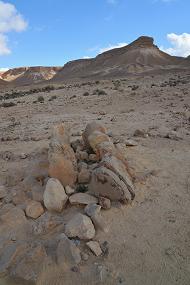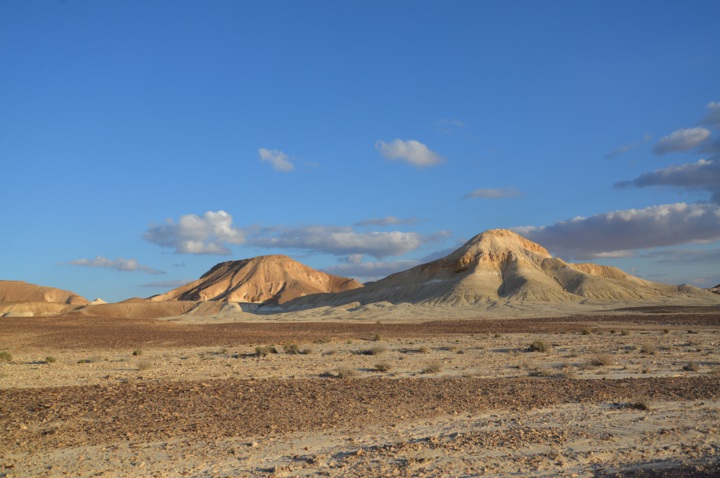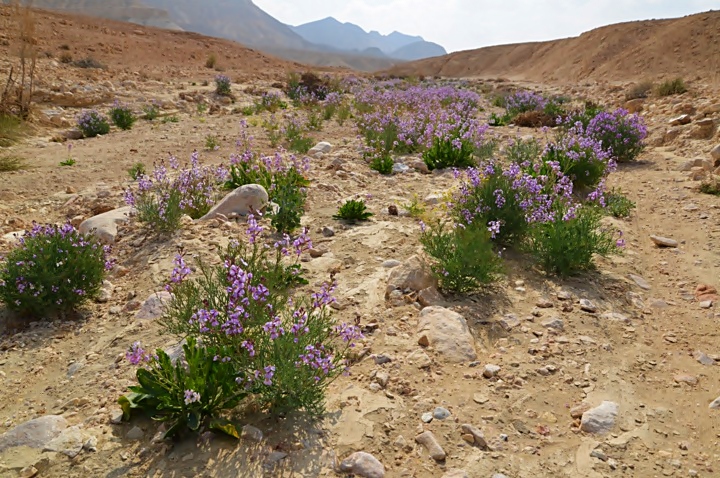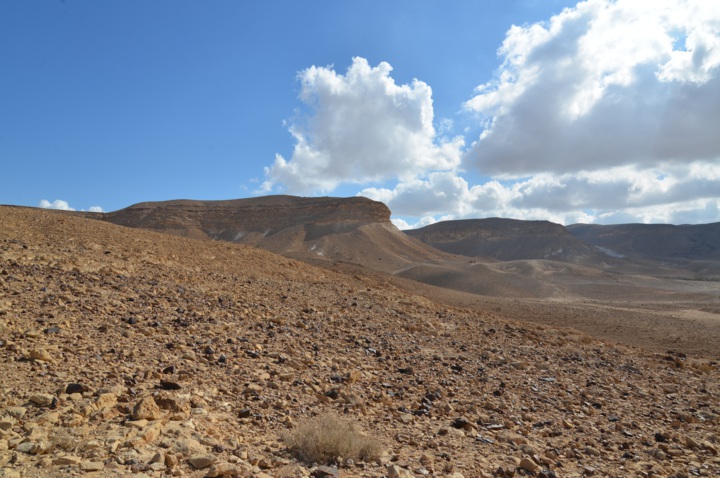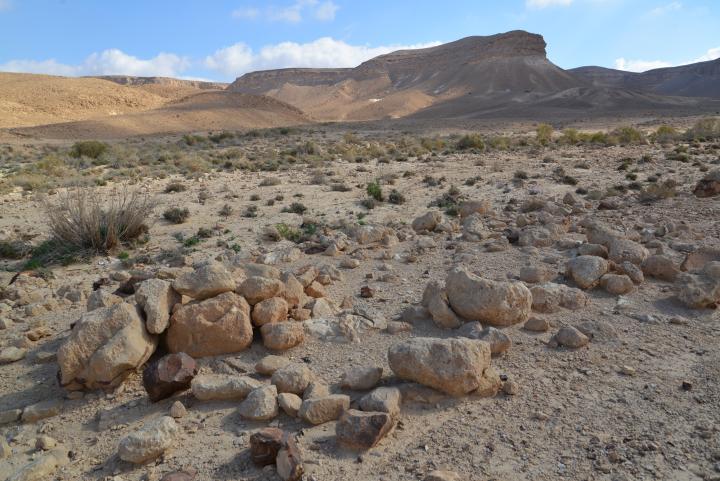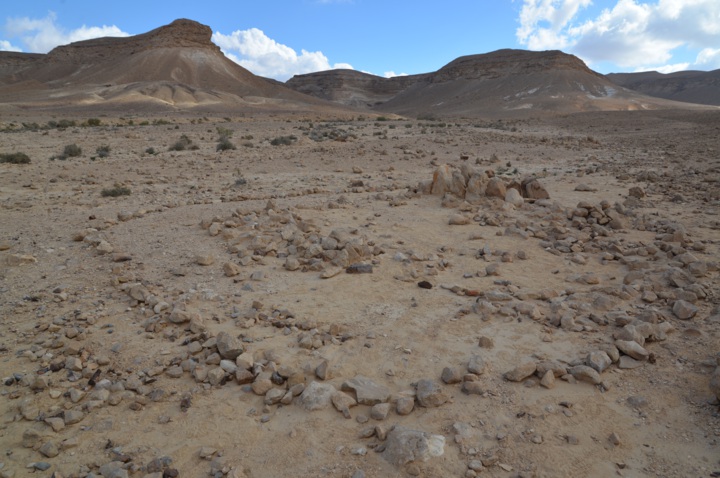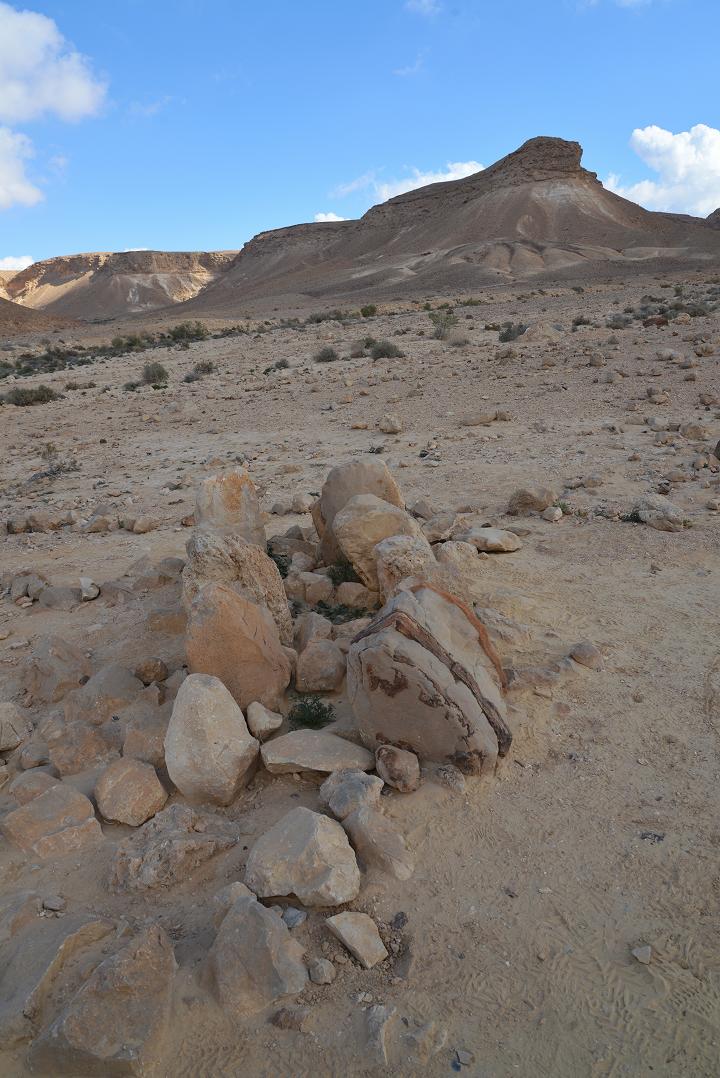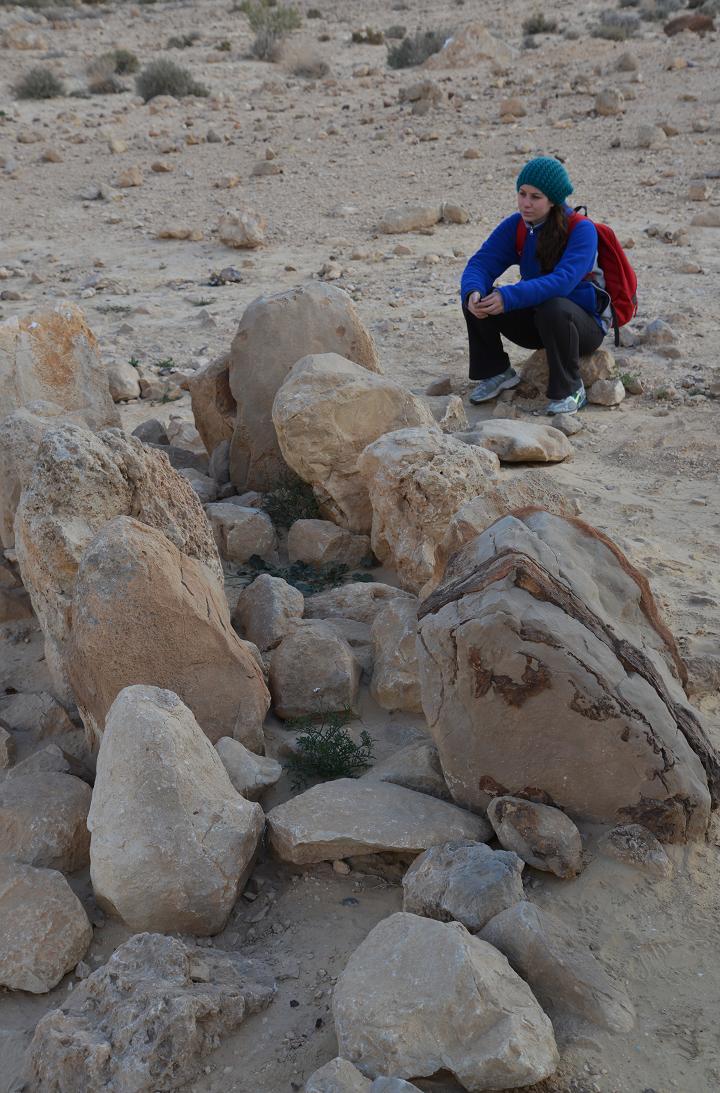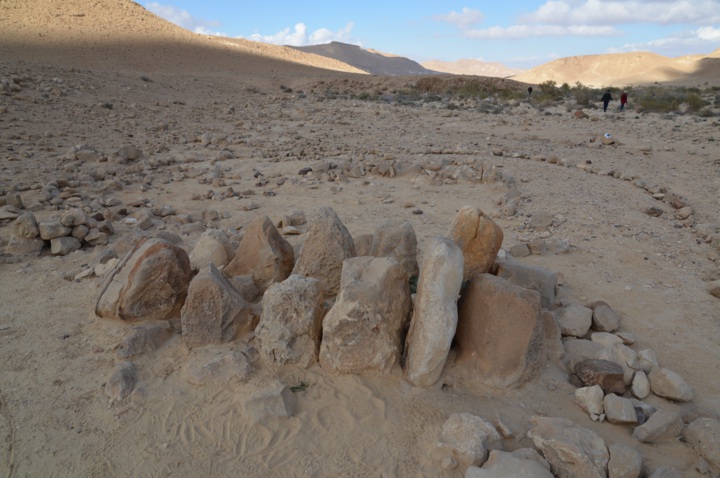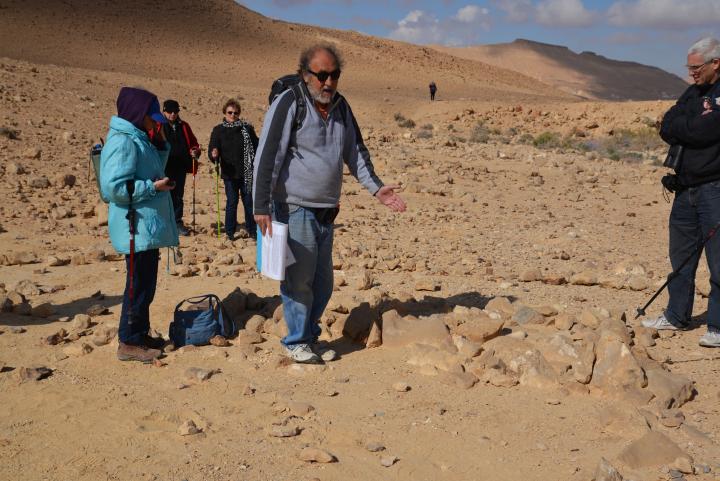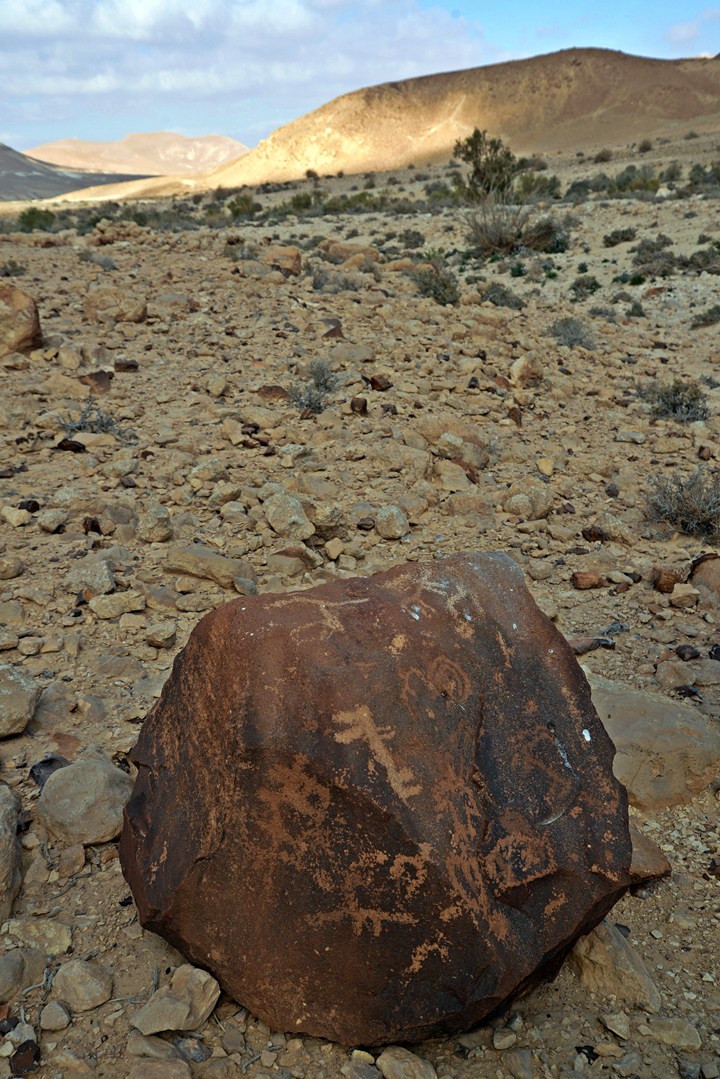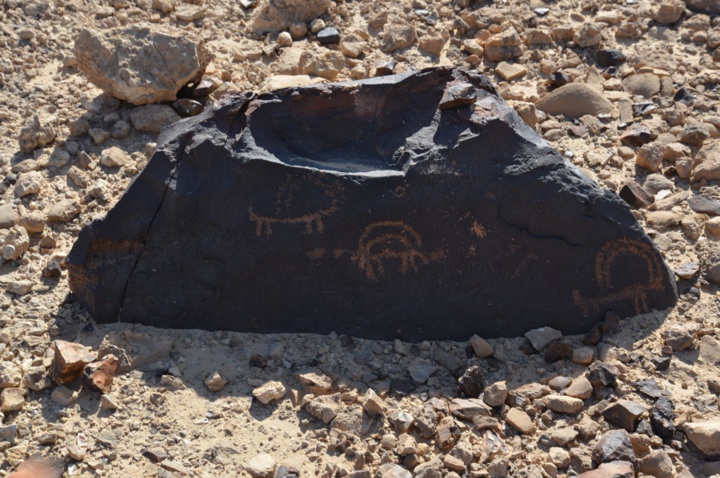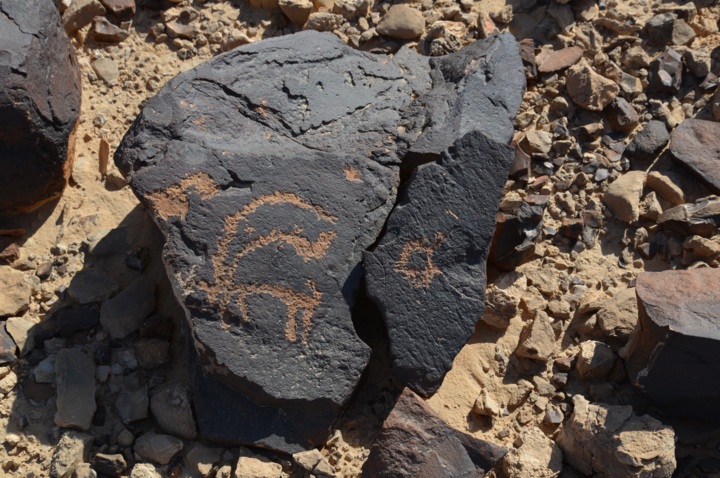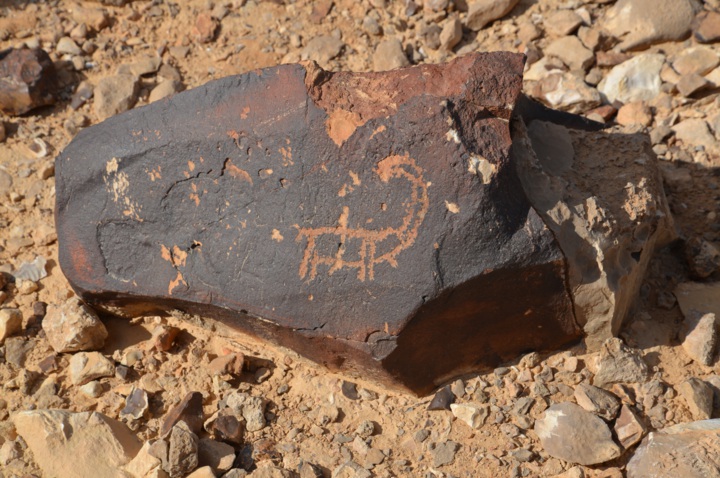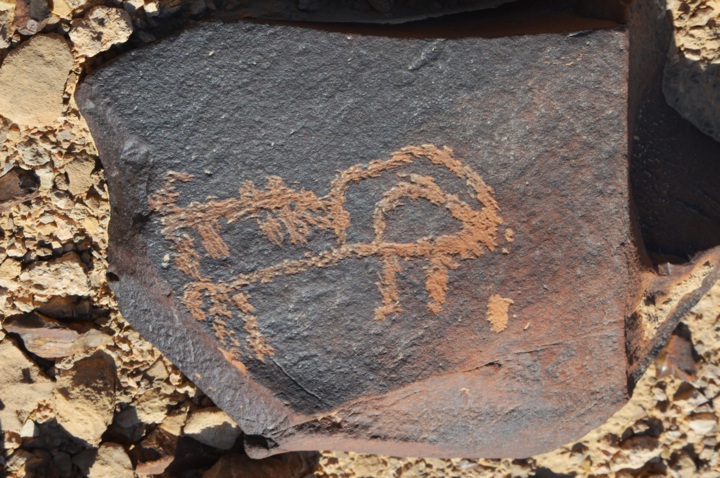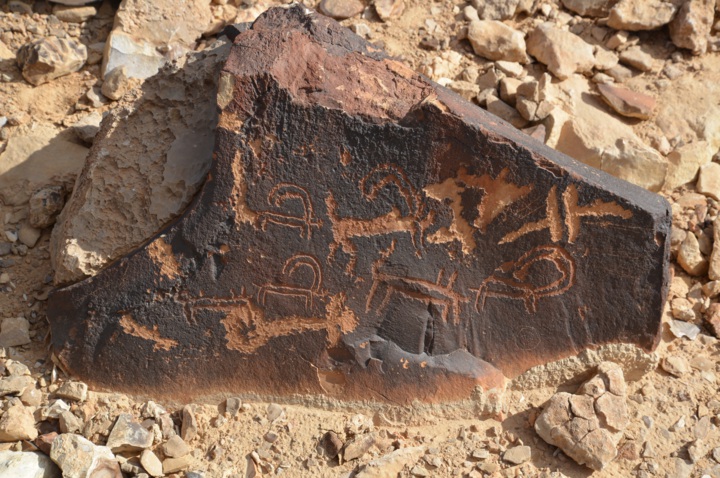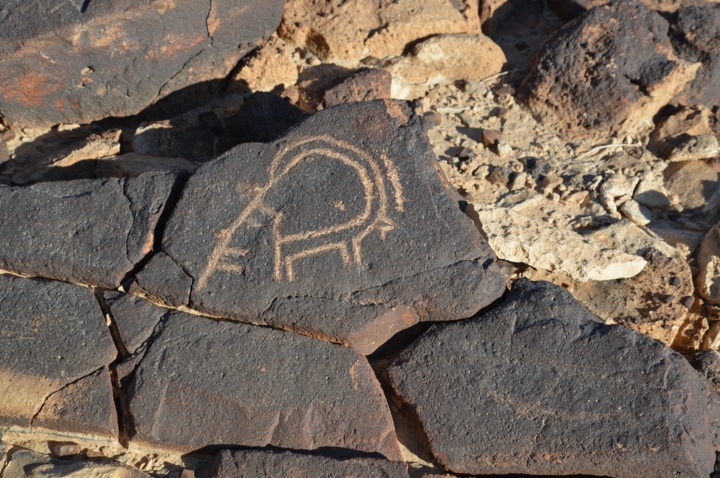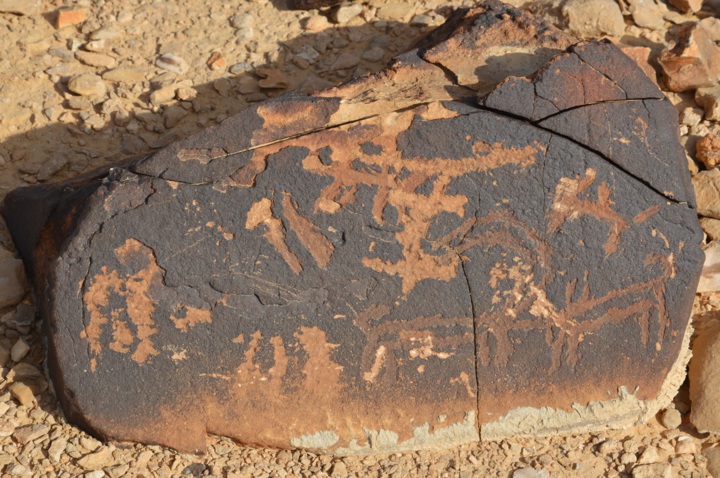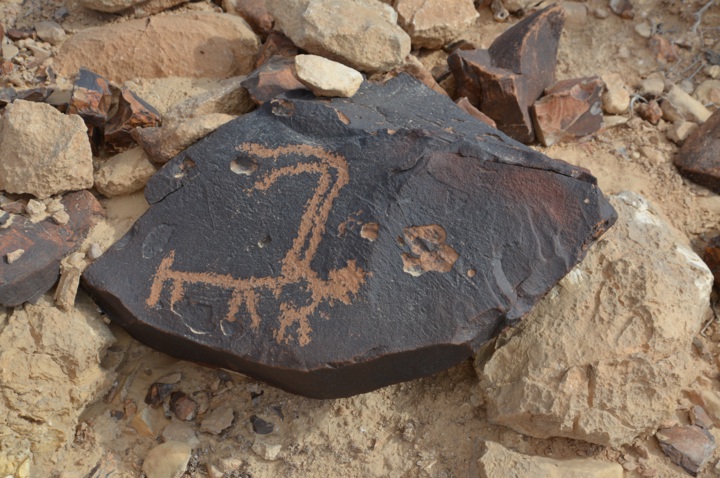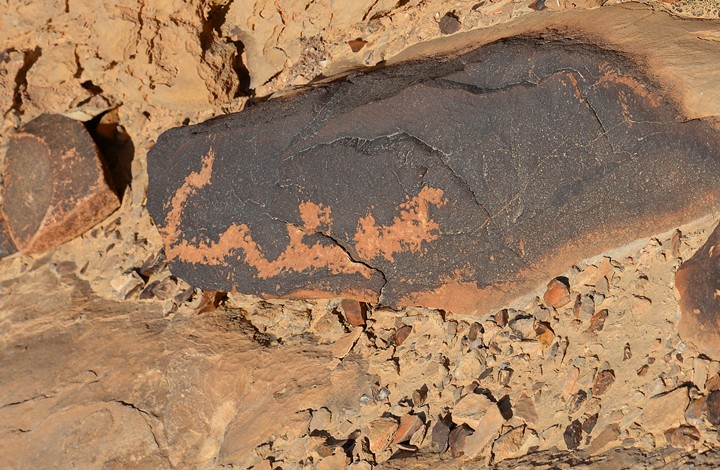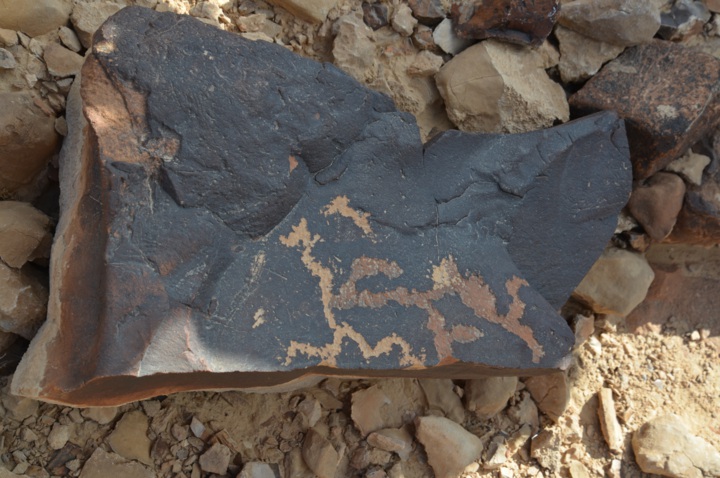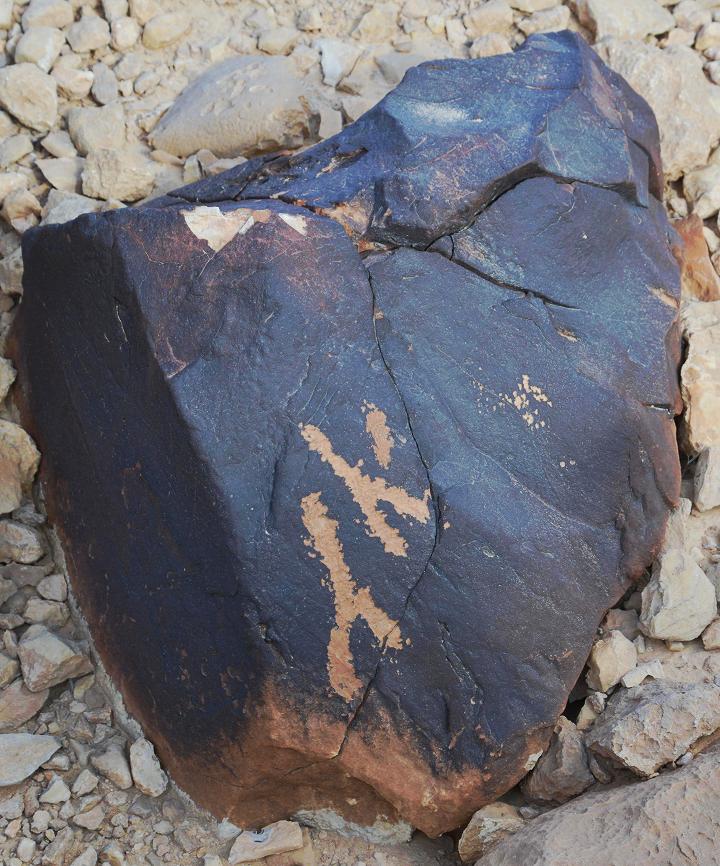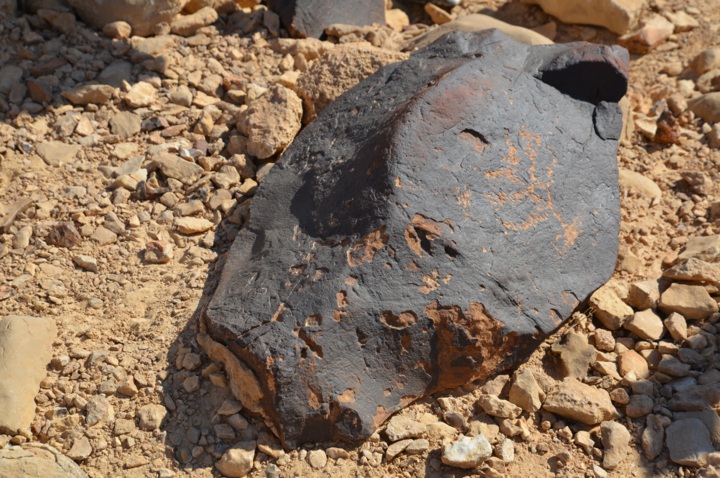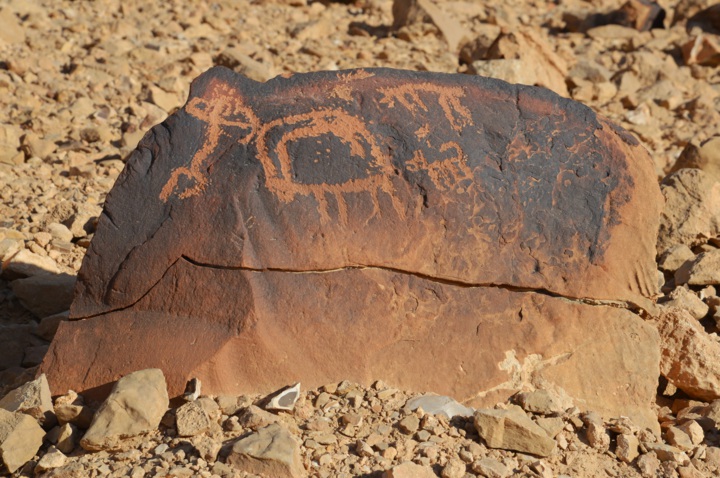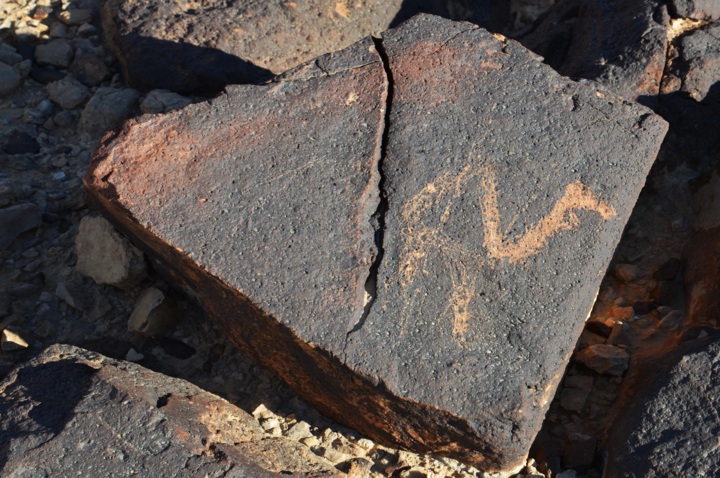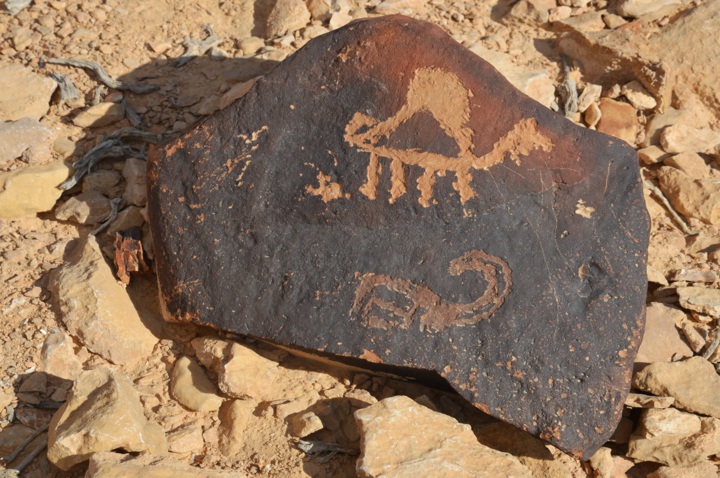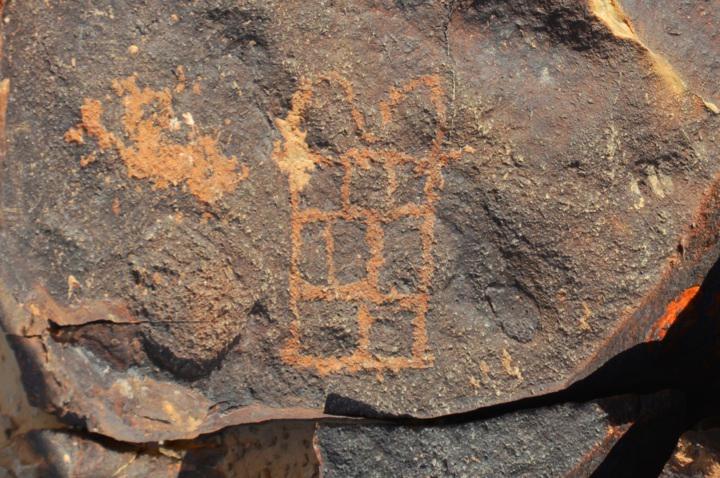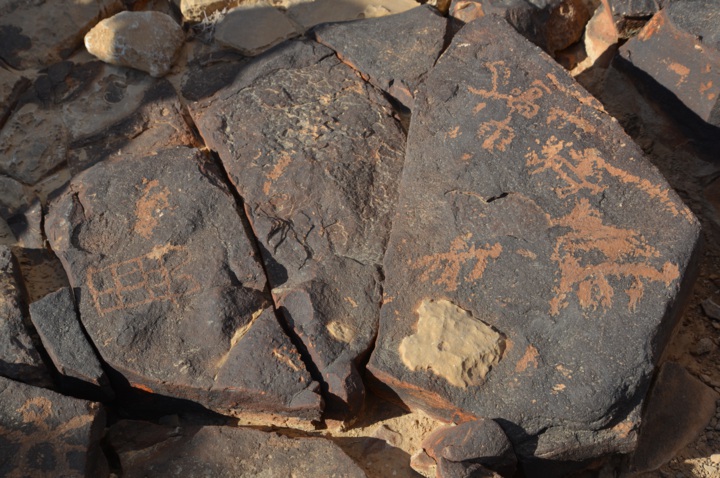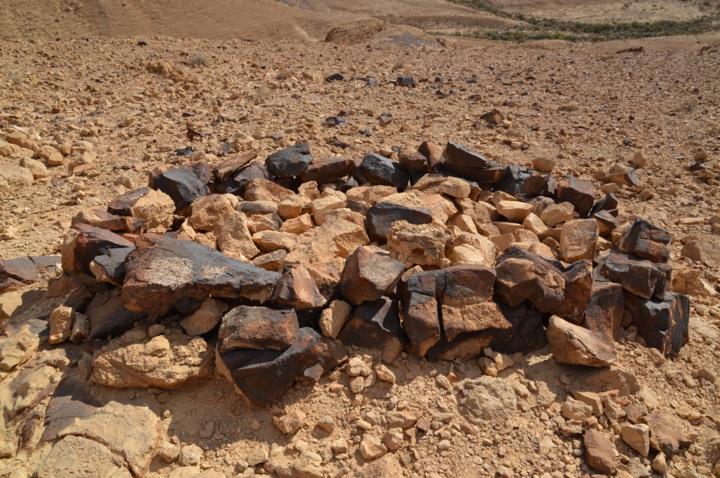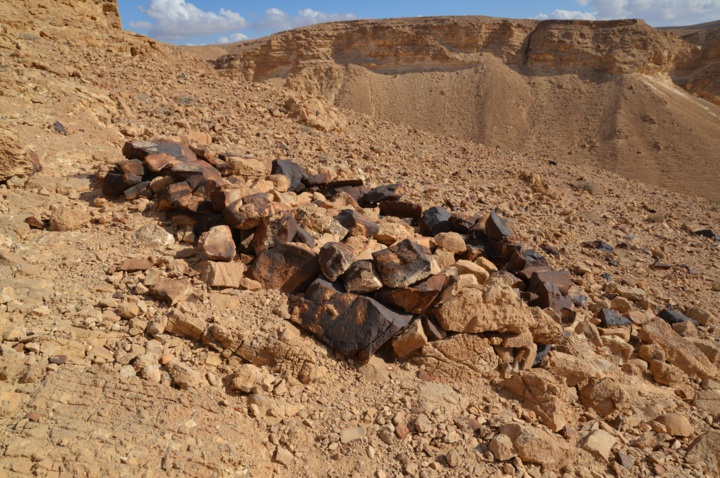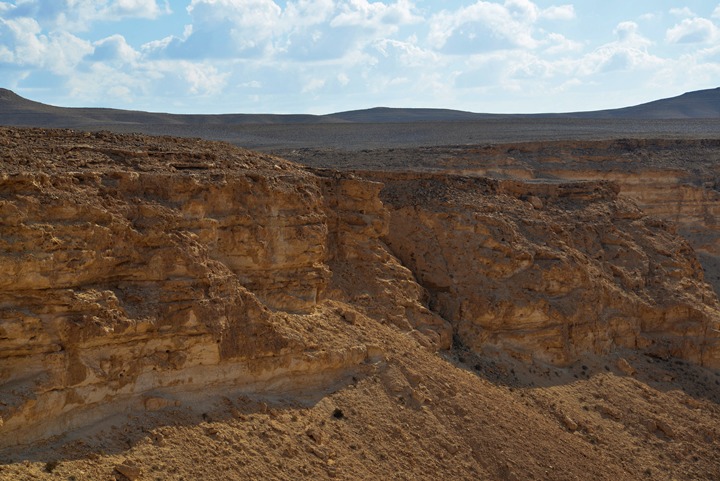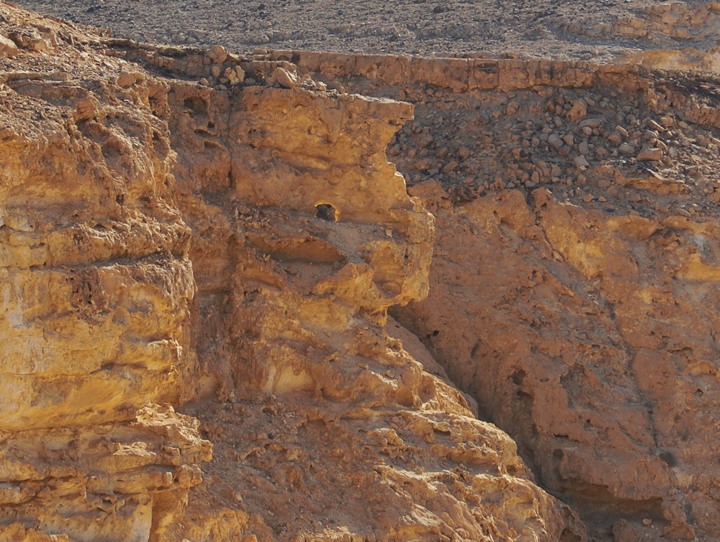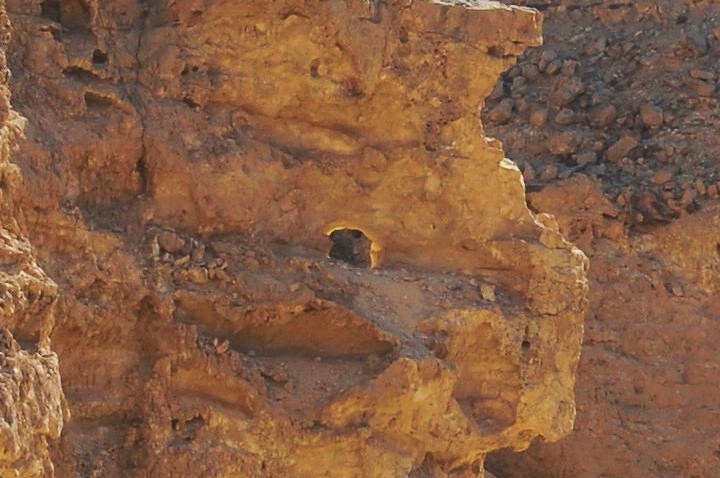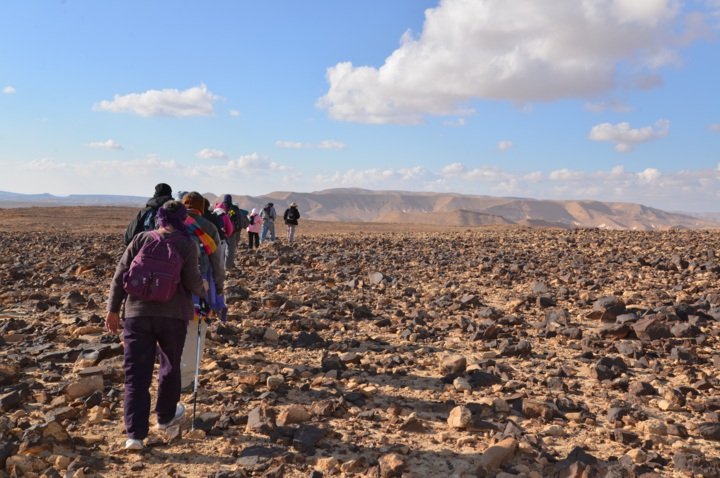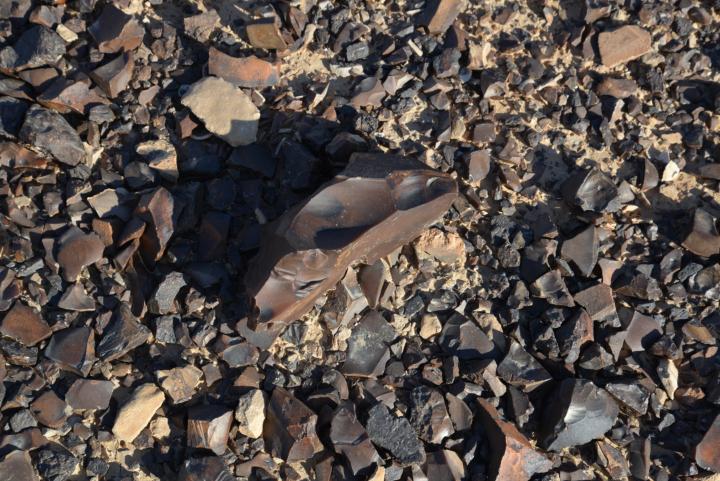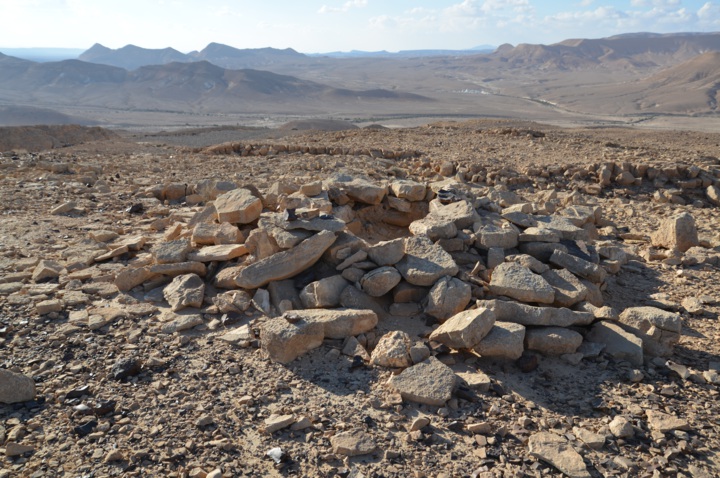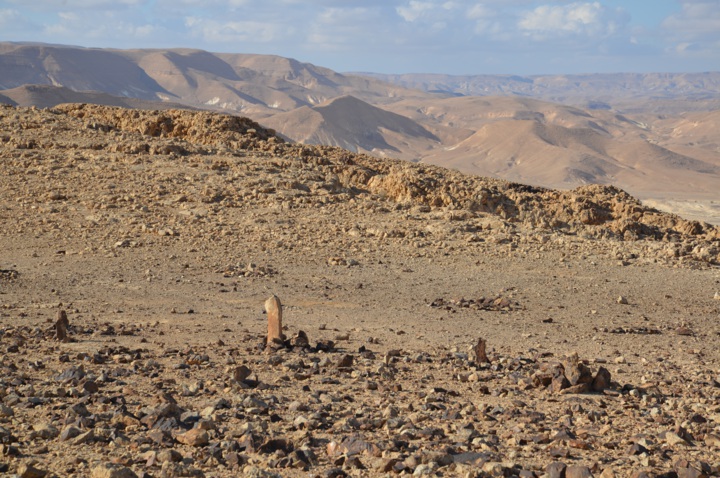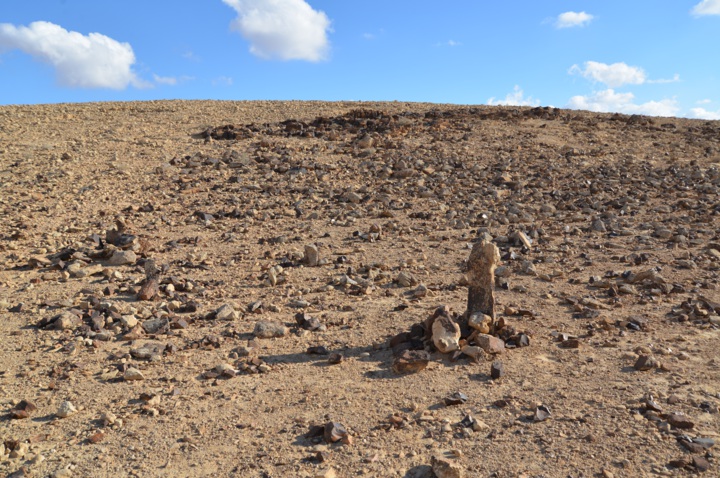A holy mountain in the Negev desert, possibly the location of Mount Sinai, where Moses received the Ten Commandments.
* Site of the Month – Mar 2013 *
Home > Sites > Negev > Mt Karkom
Contents:
Background
Location
History
Photos
* Wilderness
* Valley view
* 12 Stones altar
* Rock art
* Tablets carving
* Monument
* Burning Bush
* Top
* Midian Temple
* Panoramas
Etymology
Links
Overview:
Mt. Karkom was a holy mountain, with hundreds of archaeological sites and thousands of rock carvings on and around the mountain. The interest in this remote place in the Negev desert is due to a possible identification with Mount Sinai, where Moses received the Ten Commandments – a set of Biblical laws which are the foundations of Judaism and Christianity.
Exodus 31 18: “And he gave unto Moses, when he had made an end of communing with him upon mount Sinai, two tables of testimony, tables of stone, written with the finger of God”.
Location and Map:
The site is located in the southwest of the Negev desert, at a remote place which is hardly accessible. At current time (January 2013) the short access from road #10 along the Egyptian border is prohibited due to security reasons. Therefore, the way we reached Karkom was by 4×4 starting from Zichor junction and driving along Zichor and Paran valleys, a route possible only on weekends.
The top of Mt Karkom is flat and wide, at average height of 800m, with a peak of 847m above sea level. It is 4KM long (north-south) and 2 KM wide (east west).
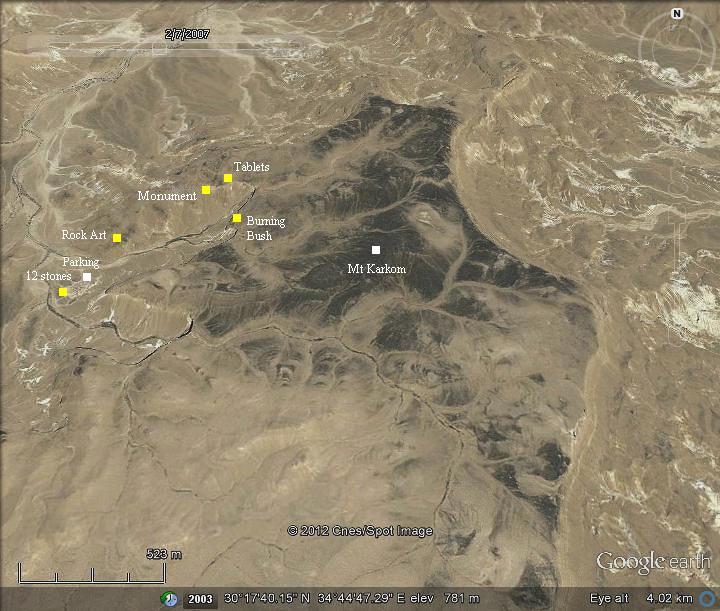
History:
-
Neolithic and Chalcolithic periods
The first nomadic society started in the Sinai and Negev deserts at the beginning of the Neolithic period (8,300 BC-4,500 BC). At about the same time (roughly 8,000 BC) goats and sheep were domesticated, which provided the means to settle the harsh conditions of the desert. However, the Negev desert did not support a permanent settlement at this time. The nomads established only random, temporary shelters, in the desert. Few rock carvings can be found in the Negev desert which date to this early stage.
The first settlements in the Negev desert date to the Chalcolithic period (4500-3150 BC). This settlement activity also parallels to the appearance of the rock carvings in the area around Mount Karkom.
-
Bronze age
During the Bronze age (3150 BC – 1200 BC) complex societies in the ‘Fertile Crescent’ region started to emerge. This region contains the moist and fertile land, and includes societies of Mesopotamia, Assyria, Phoenicia, and Egypt. The commerce between these civilizations in the Fertile Crescent passed through the Negev and Sinai deserts, bringing in a permanent wave of settlement to the Negev. These settlements supported the increase of the number of nomads in this region, since the nomads depended on the goods produced by the permanent settlers: wheat and barley, fabric and tools.
Most of the rock carvings on Mt Karkom appears at the Bronze age. The cultural influence of Mesopotamia and Egypt also affected the rock art: the figures carved by the nomads on the rocks can be attributed to these cultures.
-
Biblical times (Israelite period):
The most important event of the Bible is the Exodus. Moses frees the Jewish nation from slavery in Egypt and leads them through the desert for 40 years into the promised land of Zion. The nation is also reborn, reorganized and prepared to the conquest of Canaan.
The climax in the Exodus is the event on Mount Sinai, also called the “Mountain of God” and “Horeb”. Here Moses receives from God the Ten Commandments, which list the basic laws of Judaism. (Exodus 31 18):
“And he gave unto Moses, when he had made an end of communing with him upon mount Sinai, two tables of testimony, tables of stone, written with the finger of God”.
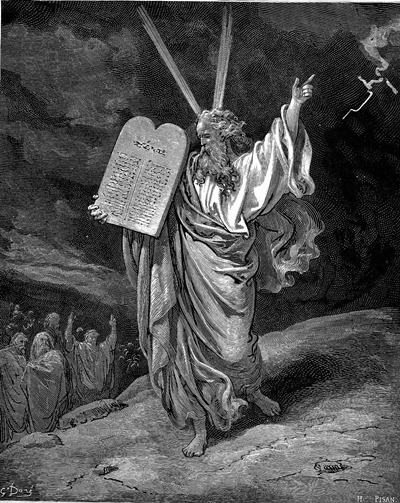
Moses comes down from Mt Sinai with the Ten Commandments
Drawing by Gustav Dore (French artist, 1832-1883)
A Biblical map is illustrated below, with the location of Mt Karkom indicated as a red square.
Although the Bible details the stations along the path of the Israelites on their way to conquer Canaan, scholars debate on the actual identification of the places, including the location of the sacred mountain of Mt. Sinai. The only certain place is Kadesh Barnea, the chief site of encampment for the Israelites. It is located northwest of Mt Karkom. Midian, the Land where Moses lived for 40 years, is located at the region east of Karkom, but its area is also questionable.
Map of the area around Karkom – during the Biblical periods (based on Bible Mapper 3.0)
So where is the Biblical Mt Sinai?
Mount Karkom is one of the candidates of the sacred mountain. There are a dozen or so other candidates. The most famous are the high mountains of the two adjacent peaks – Mt. Catherine and Jabal Musa – located at the heart of the Sinai peninsula. This Byzantine era identification, followed by a Middle Ages tradition, is based on Josephus Flavius statement that Mt. Sinai is the highest mountain. The name Sinai was given to the peninsula based on these traditions rather then facts or archaeological evidence.
The Italian archaeologist Emmanuel Anati explored the area of the Negev desert. Based on his discoveries, Anati suggested Mt Karkom as the location of Mt Sinai. He supports this claim based on the findings of thousands of rock carvings, shrines, altars, tombs which imply that the mountain area was a Holy site. The Bible called the place “Mountain of God”, implying that the area was sacred for thousands of years before the Biblical event. Furthermore, he plotted the route of Exodus in the area of the Negev desert, and the location of Karkom better fits this route. Other possible clues suggested by Anati are described in the next section.
Photos:
“Great and Terrible Wilderness”
Mt Karkom is located in a remote location in the dry Negev desert. A description of this vast and dry desert is provided in the description of the route the Israelites travelled after departing from Mt Sinai (Deuteronomy 1 19): “And when we departed from Horeb, we went through all that great and terrible wilderness, which ye saw by the way of the mountain of the Amorites, as the LORD our God commanded us; and we came to Kadeshbarnea”.
A typical scene of the dry desert is shown here, a few Kilometers away from the mountain.
Click on the photos to view in higher resolution…
Although this desert is dry and has very few green patches, there are some occasional rainy days during the winter, and we were fortunate to visit the site just after one of these storms. The rainfall flows into the valleys, which is followed days later by a carpet of flowers.
Valley View
The western side of Mt Karkom, as viewed from the entrance to the trail, is seen here from the west side. Climbing up the ridge is relatively easy.
If you imagine this place as the location of the greatest event of the Exodus, the mountain does not look impressive: it is only 250m above the valley. However, the advocates of the Mt. Sinai identification would claim that a lower mountain fits better an aging Moses (80 years old) who climbed up and down the mountain, carrying the weight of the tablets.
The flat valley around the mountain offers a suitable place for an assembly of a large crowd, such as the event of Mt. Sinai. Evidence of gathering and worship can be seen all around the mountain. This collection of stones, seen at the bottom of the picture below, is one of many altars and monuments on the foothills of Mt. Karkom.
12 stones altar
In the area of Mt. Karkom there are over 300 archaeological sites, including assembly places, 120 altars and temples, worship stages, monuments, small temporary settlements, and tombs. However, there are no permanent places of residence. The archaeological sites date to about 5,000 years ago (3rd Millennium BC) and continue until the Byzantine period. This indicates a prolonged activity of worship, and testifies to the holiness of the mountain.
One of the most interesting of these man-made arrangement of rocks is the “12-stones” altar. It is located in the valley to the south west of the mountain.
The altar is one of the most important evidences that could testify on the identification of Karkom as the Biblical Mt. Sinai. The Bible wrote that Moses erected a 12-stone altar following the delivery of the Ten Commandments (Exodus 24 4): “And Moses wrote all the words of the LORD, and rose up early in the morning, and built an altar under the hill, and twelve pillars, according to the twelve tribes of Israel”.
The altar is built near the remains of an ancient tents camp. The 12 stones are located on its east side, while on the west side (in the back of the photo below) is the stage of the altar, where the animal sacrifices were performed.
Yehuda Rotblum, the archaeologist guide who specializes in ancient rock art and Mt Karkom, points out with excitement to a interesting element in the stage area of the 12-sone altar. A sharp edge stone, which probably served as a sacrifice stone, is located on the edge of the stage. This fits the Biblical description of the sacrifice at the altar of the 12 stones (Exodus 24, 5-8):
“And he sent young men of the children of Israel, which offered burnt offerings, and sacrificed peace offerings of oxen unto the LORD. And Moses took half of the blood, and put it in basins; and half of the blood he sprinkled on the altar. And he took the book of the covenant, and read in the audience of the people: and they said, All that the LORD hath said will we do, and be obedient. And Moses took the blood, and sprinkled it on the people, and said, Behold the blood of the covenant, which the LORD hath made with you concerning all these words”.
Rock Art
In the area of Mt Karkom are 40,000 (!) figures carved on rock, mostly on dark-colored hard limestone. This is the largest cluster in the Middle East, of which a sample is shown in this section. One or more of the figures are carved on the dark rocks, with most sizes 20 to 40cm (8″-16″). They date starting from the Chalcolithic age (end of the 4th Millennium BC).
Most of the engravings date to the Bronze age (3rd Millennium BC), before the history of expressing language by an alphabet (Proto-Sinai script, about 15th C BC). At about 13th C BC there is a gap of 1,000 years, and the rock carvings continued from the Hellenistic period (3rd C BC) until the end of the Byzantine period (7th C AD).
The rock in the following picture is located near the 12-stones altar. A number of icons of animals appear on the face of the rock – dogs and Ibex. Additional strokes of lines and other symbols appear on the rock.
Rock art is a common phenomenon from over the whole world. What are the meanings and purposes of this rock art? If they can be interpreted, their story could explain why this mountain is Holy for thousands of years, and perhaps prove that this was the Biblical Mount Sinai.
The conventional wisdom is that the rock art represents daily nomad life – hunting scenes, animals, tools, and other themes. Most of the carvings predated the history of written text, so their interpretation could provide us information on the earlier stages of civilization. Nomad life actually emerged from the Sinai and Negev deserts, its research could shed light to the evolution of man in general and the history of Israel and the Negev desert in particular.
Scholars propose various explanations to this riddle. We provide here both the “conventional wisdom” of nomad life scenes, and also add other theories such as the relationship between the carved icons to the constellations and the cycles of day/night and seasons, such as suggested by Yehuda Rotblum.
- Ibex – mountain goat
The Ibex mountain goat (Ya’el) appears in 80% of the carved rocks on Mt Karkom. It is illustrated by a pair of curved horns (its prominent feature), flat body and legs. The Ibex either as a single or multiple instances, as below, or together with dogs, hunters, snakes and other animals.
The Ibex is a common desert animal, as written in Psalms 104:18: “High mountains for ibex and rocks to shelter hyrax“.
Ibexes were not hunted at the time of the rock art, therefore it is not associated with the economical virtues of the Ibex. Furthermore, a high percentage of Ibex bones appear in tombs. A parallel phenomenon could also be found in Europe and Asia where similar horned animals are found in tombs and rock art. Therefore, it can be assumed that the frequent appearance of the Ibex on the rock carvings indicates that the horned Ibex was associated with worship.
Ibex – the mountain goat
- Ibex as a Cosmic symbol
Some of the rock carvings include the Ibex with the moon, sun and stars. The example below shows the horned animal is holding the moon within its horns, with the large ball of the sun in the center, and the stars on the left side. Y. Rotblum suggested (“Heavenly Art”, p. 249-250) that this motif is one of the ways the early man attempted to explain the cosmic order: why does the heavenly bodies circle in the sky. It is the Ibex, as per this primitive belief, that is behind the cosmos.
- Ibex and Dog
Many rock carvings in Karkom depict an Ibex with a large dog.
Two pairs of Ibex & Large Dog is also seen on the bottom corners of the next rock. In this carving, more Ibex animals appear above the two pairs, as well as other signs.
These carvings could be be simply interpreted as a capture of a daily scene, but may also be based on other more complex interpretations. The interaction between the Ibex and the dog is a common subject in Egyptian mythology, which influenced the rock art of the Negev desert. It is also known in other cultures.
Another Ibex and Dog carving is seen in the next picture.
Another Ibex & Dog carving is seen on the bottom right of the next rock, with additional carvings above them.
Y. Rotblum suggested (“Heavenly Art”, p. 236-240) that the Ibex-Dog illustration is related to stellar constellations:
- The Ibex represents the Orion constellation, which is one of the famous constellations, distinguished by the triplet of stars (“the hunter’s belt”).
- The dog represents the Canis-Major (“large Dog”) constellation, which looks like a dog (see illustration). It includes the brightest star of the sky – Sirius.
- Both constellations appear in the sky at a small distance between them, as seen on the star map on the right. The position of the dog and the ibex on this rock closely matches the positions of both constellations.
Constellations of Orion, Canis Major and Minor
- Ibex and hunter
In this rock art a hunter struggles with the Ibex. It looks like he is trying to pull its horns.
Y. Rotblum suggested (“Heavenly Art”, p. 253) that this scene represents the cycle of day and night: the sun is a ball on the right side, and the “hunter” (Orion constellation of the night) tries to free the animal from holding the sun. This struggle is associated with the belief of the early man: the Ibex steals the sun from the underworld (night), and brings it up to the sky (day). The hunter returns the sun back to the underworld (night again). This is an endless cycle of nature, and the early artist captured it on the stone.
- Sun Eclipse
Another sky-gazing theme in ancient rock art is sun eclipse , which was a frightening event at those times. One of the carvings in Karkom can be interpreted as an icon of a mean animal eating up the sun (Y. Rotblum, “Heavenly Art”, p. 181-186). The “sun-eating monster” in the following picture is on the left, while the “sun” is on the right.
- Struggle between Ba’al and Mot
The following carving can be interpreted (Y. Rotblum, “Heavenly Art”, p. 273) as the struggle between two Gods – Ba’al (“master”) and Mot (“Death”). This heavenly struggle represents the cycle of seasons: winter and summer. Ba’al, seen here on the left side, is the God of rain, storms and fertility. On the right side is Mot, the God of summer, droughts and infertility. The good God – Ba’al – has the upper hand, and uses lightning (illustrated as an arrow above his head) to defeat the weaker Mot.
- Name of God
One of the interesting rock carvings is this one with 3 icons, that could be interpreted as the name of God.
Assuming that the icons are letters of the “proto-Sinai/Canaanite” alphabet, the 15th C BC origin of Hebrew and most alphabets, then these letters are Yod-Hei-Hei, a short form of the name of God (Y. Rotblum, “Heavenly Art”, p. 266).

“Hei” “Hei” “Yod”
Alphabet of Serabit elKhadim, turquoise mine in Sinai
- Menorah?
A carving of a menorah (lamp stand) is one of the interesting carvings on the upper side of the north side of the hill. This icon may, of course, also be an icon of a tree or bush (burning bush?).
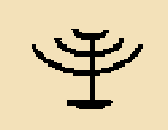
The design of the menorah as a holy instrument was commanded by God to Moses on Mount Sinai, and became one of the symbols of the Jewish faith (Exodus 25 31-32): “And thou shalt make a candlestick of pure gold: of beaten work shall the candlestick be made: his shaft, and his branches, his bowls, his knops, and his flowers, shall be of the same. And six branches shall come out of the sides of it; three branches of the candlestick out of the one side, and three branches of the candlestick out of the other side:”.
- Hunting Scene
The following rock art picture illustrates a hunting scene, and could simply be an illustration of a daily event by the early artist.
However, Y. Rotblum analyzes this rock art as a mythological story which illustrates the transition from summer to winter (“Heavenly Art”, pp. 254-255): The hunter on the left side is the God of underworld. The two dogs are the hunter’s assistance, pushing the ibex from the right. Note that dogs are depicted as the keepers of the underworld, as in Egyptian and Greek mythologies. They are all pushing the sun (a circle on right side of the horns of the ibex) back to its place. Below the ibex is a crack in the rock, where a fire is carved – symbolizing the underworld.
Another interpretation of this hunting scene is the daily cycle between day and night. The sun is carried by the Ibex, who steals it from the underworld and brings back the light of the day. At the end of the day the hunter (the Orion constellation) and his dogs (the Canis-Major and Minor constellations) push the sun back into the underworld where it rests during the night.
- Camels
This rock carving of the next picture is of a camel.
Camels are the main transportation vehicle in the Biblical times. They are referred many times in the Bible while describing travel or property (they were important assets).
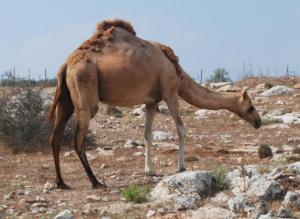
The Camel’s ability of carrying heavy cargo due to their strength, and the ability to handle the dry conditions of the desert area with few stops for water – made them the best pack animals in the ancient times. A typical number of camels (50,000!) and relative ratio to other beasts (25 more times than asses) can be seen in a description of the battles of Reuben tribe against the Hagrites (1 Chronicles 5 21):”And they took away their cattle; of their camels fifty thousand, and of sheep two hundred and fifty thousand, and of asses two thousand, and of men an hundred thousand”.
In the next photo, the camel is the animal carrying the sun:
Tablets of Stones
A most interesting carving illustrates the tablets of stones, known as the tablets of the covenant. This is one of the proofs brought in to associate Mt Karkom with Mt Sinai, where Moses received the Ten Commandments. (Exodus 31 18): “And he gave unto Moses, when he had made an end of communing with him upon mount Sinai, two tables of testimony, tables of stone, written with the finger of God”.
The carving appears on a rock on top of the western side of the hill. It appears on a rock with additional carvings of a hunter and bow (probably “Orion” constellation?), two dogs (the Canis-Major and Minor constellations?) and Ibex (carrying the sun?). The lines of the tablet illustration are thinner then the other symbols, since it was inscribed at a later date.
Summary: There are many thousands of rocks to investigate their carvings and wonder what they mean. Why not go there and try to unravel the mystery of the rock art for yourself?..
Monument or Altar
Along the trail that ascends to the top of the hill is a mysterious circle of stones. Along the peripheral of the circle are black stones, and inside the circle are bright yellowish stone.
This might have been either an altar, or a monument to some important event. The archeologists dug into the circle in order to explore it, then returned the pile back to its original state. They did not find bones, ruling out its use as a tomb. What they did find was a single small white cube! What did the cube mean to the builders of this pile of stones?.. Yet another puzzle to solve.
This pile of rocks was apparently a monument. The Bible described the erection of several monuments. For example, the case of the monument (Hebrew: Galeed) of Jacob and his uncle Laban (Genesis 31, 44-48):
“Now therefore come thou, let us make a covenant, I and thou; and let it be for a witness between me and thee. And Jacob took a stone, and set it up for a pillar. And Jacob said unto his brethren, Gather stones; and they took stones, and made an heap: and they did eat there upon the heap. And Laban called it Jegarsahadutha: but Jacob called it Galeed. And Laban said, This heap is a witness between me and thee this day. Therefore was the name of it called Galeed;”.
Burning Bush
When Moses was keeping his father-in-law’s flock in the desert, he came to the “mountain God”, and witnessed an extraordinary vision – a burning bush which was not consumed from the fire. God spoke from the bush and assigned him with the leadership of the nation and the task to free them from the Egyptian slavery (Exodus 3 1-5):
“Now Moses kept the flock of Jethro his father in law, the priest of Midian: and he led the flock to the backside of the desert, and came to the mountain of God, even to Horeb. And the angel of the LORD appeared unto him in a flame of fire out of the midst of a bush: and he looked, and, behold, the bush burned with fire, and the bush was not consumed. And Moses said, I will now turn aside, and see this great sight, why the bush is not burnt. And when the LORD saw that he turned aside to see, God called unto him out of the midst of the bush, and said, Moses, Moses. And he said, Here am I. And he said, Draw not nigh hither: put off thy shoes from off thy feet, for the place whereon thou standest is holy ground.”.
On top of Mt Karkom there is an optical phenomenon which can be associated with the burning bush event. A hole in the hill glows in the sun, and seems like it is “burning”.
Looking closer to the edge of the ridge is the “burning bush”: a halo around the hole is unique and remarkable.
A closer view of the halo is seen in the next picture. Perhaps Moses observed this halo and visualized it as a burning bush?
Top
The hill is barren and dry. Its surface is covered by fragments of rocks, some of them bright yellowish limestone, and others sun-burnt darkened stone.
There are also areas covered with flint, which is unique for the hill – distinguishing it from other mountains. The flint carpet is one of the identifiers of Mt Sinai, as described in the Bible at the location (aka: Horeb, mountain of God) of the burning bush (Exodus 17 6): “Behold, I will stand before thee there upon the rock in Horeb”. The rock in the Hebrew version of this verse is Zor (flint), thus increasing the probability of Karkom’s identification as Mt Sinai.
Flint was used for the manufacturing of tools and weapons during the ancient periods. A large collection of flint tools and cuttings was found near the ancient Chalcolithic (?) period tomb.
Midian Temple
Close to the top of the hill are traces of ruins of a Midian temple, as identified by Immanuel Anati.
Midian was the land where Moses hid during his 40 years exile from Egypt, where he married the daughter of Jethro, priest of Midian. The location of Midian is not certain, but may have been in the area of Eilat and the Arabah valley- southeast of Karkom.
This temple could have been the place where the elders of the Israelites waited for Moses to come back from the mountain, and where God appears before them (Exodus 24, 9-11):
“Then went up Moses, and Aaron, Nadab, and Abihu, and seventy of the elders of Israel: And they saw the God of Israel: and there was under his feet as it were a paved work of a sapphire stone, and as it were the body of heaven in his clearness. And upon the nobles of the children of Israel he laid not his hand: also they saw God, and did eat and drink..”.
Panorama
A set of panoramic views, as seen from the top and foothill of Mt Karkom, are shown in the following pictures. If you press on either one, a panoramic viewer will pop up. Using this flash-based panoramic viewer, you can move around and zoom in and out, and view the site in full screen mode.
To open the viewer, simply click on the photos below. It will open a new window, for each of the two views, after a minute or so.
Hill view:
Valley View:
Etymology (behind the name):
* Names of the site:
- Karkom – modern name of the site, named after the Carcus Sativus flower. The saffron spice is made from this flower.
Karkom-Saffron is listed in the Bible as one of the sources of perfume (Song of Solomon 4, 14): “Spikenard and saffron; calamus and cinnamon, with all trees of frankincense; myrrh and aloes, with all the chief spices:”.
- Mt. Saffron – another name of the mountain, based on the spice
- Jabal Ideid – the Arabic name of Karkom
Links and References:
* References:
- “Heavenly Art” – Interpretation of Stone Carvings in Israel; Book by Yehuda Rotblum [ Karkom publication, 2012, Hebrew, 289 pages]
- The Riddle of Mt. Sinai Immanuel Anati (2001)
* External links:
- Is Mt Karkom the Biblical Mt Sinai? Yehuda Rotblum (pdf)
- Har Karkom preliminary report
- How can I find Orion? Orion finder chart
- Constellations map clusters of the “fixed” stars
* Other:
- Biblical pictures by Gustave Doré (1832-1883) – public domain
- Tagliot – who conducted the tour to the site (Hebrew)
* Internal links:
BibleWalks.com – following the paths of the Bible
Tamar <—previous site—<<<All Sites>>>—next Negev site—> Lost City
This page was last updated on Jan 28, 2013
Sponsored links:
